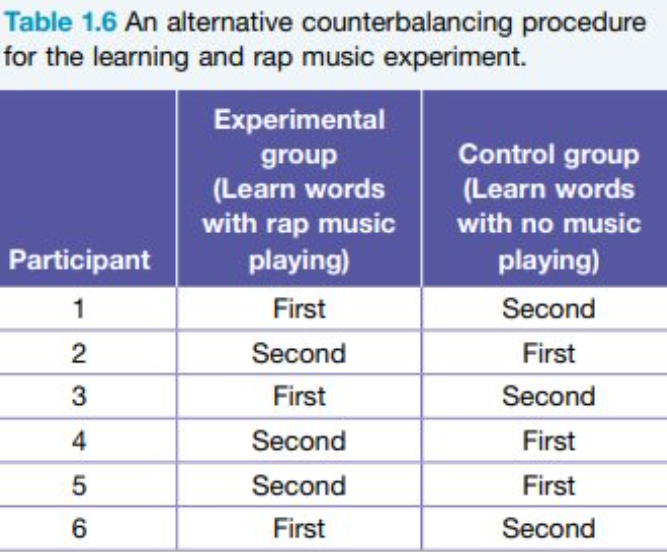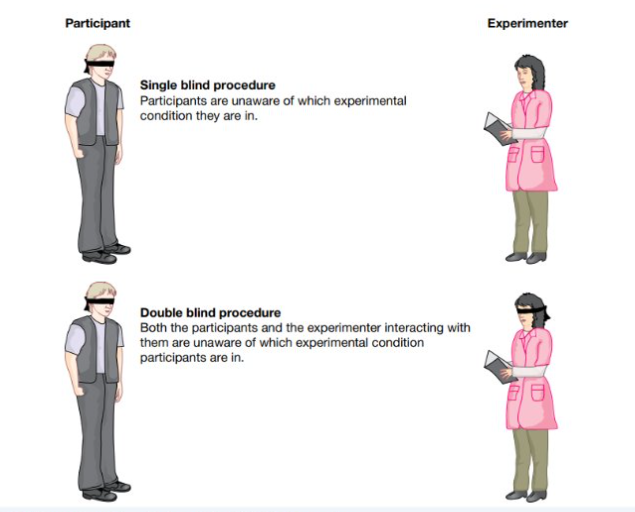11.Types Of Extraneous Variables & Their Controls
Types include:
Participant variables
Situational variables
Demand characteristics
Experimenter effects
Placebo effects
Acronym:
Poor Students Do Expect Paychecks
Participant variables
Personal characteristics that individual participants bring to an experiment & which could influence their responses
May be biological, psychological &/or social in nature
Factors include:
Intelligence
Memory
Age
Diet
Sleep patterns
Cultural experiences
Acronym:
I Made A Dinosaur Sandwich - Crunchy!
Control
Aim is to ensure that participants in different experimental conditions are as similar as possible in personal characteristics that may have unwanted influence on the result.
(with large number of participants)
Obtaining variables via random sampling to ensure sample is representative of the population being studied
random allocation to ensure each group will end up with a uniform of spread of participant characteristics in each condition so that the effects of the DV can cancel
appropriate experimental design, will be dependant on factors such as: Hypothesis being tested, Number of participants available, How the DV will be measured, Practical constraints.
Within subjects design more effective for controlling participant variables as each participant performs under all conditions in experiment
Between subjects design reduce likelihood of differences as random allocation to different conditions will help ensure groups are well matched on participant variables
Situational variables
External factors other than IV associated with the experimental setting that may influence participant response and result.
background noise
time of day
temperature
presence or absence of other participants
instructions & procedures used by researcher
Experiment that uses non-standardised instructions & procedures does not strictly control all possible extraneous & confounding variables that can influence DV
Order effect (practice + carryover)
order effects arising in within subjects are also situational variables
occur when performance on DV is influenced by specific sequence in which the experimental tasks are presented rather than the IV. Performing one tasks affects performance of the next (can be better or worse)

Practice effects:
when repeating/prior experience with the tasks can be improve (when participants become more familiar with task) or be impair (due to fatigue, tiredness or boredom) performance
includes: Test materials, procedures & settings
Carryover effect:
effects of experiencing task can carry over to next task regardless if task is similar or different
influences that a particular tasks has on the performance in the task that follows it
eg/ Emotions or substances that may linger in the body may improve or lower performance in later trials.
Control:
Most effective way to control most situational variables is to hold them constant during experiment
all participants in different conditions must be tested in the same way and in the same situation for experimenter to conclude IV was manipulated by DV
Should be considered when planning an experiment to ensure they are eliminated, minimised or occur in all conditions if can not be controlled
Control Order Effects:
Counterbalancing involves systematically changing sequence of treatment or tasks for participants in a balanced way to reduce or avoid unwanted effects on performance of any order
→ can be done by alternating order in which participants or group are exposed to IV


Demand characteristics :
Cues in an experiment that may influence or bias a participants response
Cues suggest a kind of response experimenter is wanting or expecting and leads participants to believe they should respond in that way
may be produced by experimenter or setting
eg/ Participants guessing hypothesis & attempting to act in ways they think will support hypothesis
→ results in non-natural responses to variables in investigation
Control:
Deception, Blind procedures, Experimental Design
Deception can help ensure participants respond more naturally by concealing purpose of experiment through misleading and misinforming participant.
→ can be used if potential benefits of result outweigh harms
→ there is no other options viable
single blind procedure keeps participants unaware of experimental conditions they are in
double blind procedure is where both participants and experimenters who interacting are unaware of conditions in which participants have been allocated, and only researcher that is removed from actual research situation know which participants are in which condition.
→ prevent experimenter cues while controlling participant expectations

Appropriate experimental design
No within subject designs
Standardised instructions, minimising cues in environment & ensuring all participants in each conditions have the same experience
take into account the possibility that participants discuss experiment which they have the opportunity to do so.
Experimenter effect
refers any influence experimenter may have on the results of their investigation
can occur though:
interaction with participants
unintentional errors when making observations, measuring responses, analysing or interpreting results
personal characteristics of the experimenter : Age, gender, Ethnic appearance, Cultural background, Accent, Attitude, Biases, Expectations [ACE-BAGE]
Experimenter Expectancy
involves cues experimenter provides about responses participants should make in experiment , which can produce a self-fulfilling prophecy.
Also involves unintentional errors or biases in treatment of data when analysing results (unconscious mistakes)
Actions that may contribute:
Facial expressions → smiling at one group of participants but not at another
Mannerisms → shaking hands with participants in one group
Tone of voice→ speaking differently depending on the group
Free My Time
Control:
double-blind procedure
only researcher or research assistant who has no personal contact with research participants is aware of this information.
triple blind procedure: Participants, experimenters involved and research assistants are unaware of experimental conditions. Digital technology can keep experimenters blind as to who is in which condition.
Automating data collection ensures that the score system is consistently & accurately applied
Placebo Effect
Fake or inactive treatment that substitutes for a real substance
Change in participants behaviour due to belief that they are receiving some kind of experimental treatment and respond in accordance with that belief rather than the effects of the IV
to minimise placebo effect on DV, Control group can be given Placebo
Control should form same expectations as experiment group, controlling effects of unwanted variable
